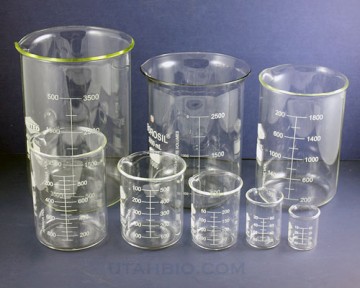Process Name: Glass substrate cleaning
SOAPCLEAN + SOLVENTCLEAN + HCLCLEAN + HNO3CLEAN + AQUAREGIA
Author:
Mark Bachman, Fall 1999, edited for ANF by M. Beaudoin, 2014
Overview:
Glass slides wafers are often cleaned by a solvent clean, followed by a dionized water (DI) rinse, followed by a mild acid clean, DI rinse and blow dry. This is a dangerous wetbench process and requires qualification for dangerous wetbench processes. The use of dangerous chemicals requires that the user may not perform the process alone.
Time Needed:
The total process takes approximately 50 minutes.
Materials Needed:
Soap solution
Acetone
Methanol (or Isopropanol)
Dilute hydrochloric acid (30%)
Dilute nitric acid (30%)
Pyrex bath containers
Preparation:
Soap clean
Most slides and glass surfaces can be effectively cleaned with soapy water. Prepare a bath of soapy water. Use a lint-free wipe and cotton swab to gently rub the surface clean of dirt and residues. Rinse thoroughly in DI water and blow dry with nitrogen.
Solvent clean
Setup time for this process is about 5 minutes. This process takes about 15 minutes to complete. Don protective gear: eye protection and nitrile gloves.
Solvents can clean oils and organic residues which appear on glass surfaces. Unfortunately, solvents themselves (especially acetone) leave their own residues. This is why a two-solvent method is used. Pour acetone into a glass container. Pour methanol in a separate container. Place acetone on hot plate to warm up (do not exceed 55 °C). Place silicon wafer in warm acetone bath for 10 minutes. Remove and place in methanol for 2–5 minutes. Remove and rinse in DI water. Blow dry with nitrogen. If the solvents are clean and you intend to use them again, store in an appropriately labeled container. If not, pour used acetone and methanol in the solvent waste container. Do not pour solvents down the drain.
HCl clean
Setup time for this process is about 5 minutes. This process takes about 35 minutes to complete. Don protective gear: eye protection and nitrile gloves
Hydrochloric acid can be used to clean glass. It does this by mildly etching the surface of the glass. Prepare an HCl bath in a polypropylene container by the following recipe.
- 200 ml DI water
- 100 ml HCl (add to water)
Pour the water in the container, then add the acid. Be sure to label the container with the title “30% HCl solution”, then add your name and the date. Put the glass substrates into the bath to soak for 30 minutes. For extra clean surfaces, soak for 24 hours. Rinse in DI water, then blow dry. If the acid solution is clean and you intend to use it again, store it in an appropriately labeled container. If not, pour the acidic solution into the acid waste container.
Nitric acid clean
Setup time for this process is about 5 minutes. This process takes about 35 minutes to complete. Don protective gear: eye protection and nitrile gloves. Nitric acid can be used to clean glass. It does this by leeching the ions from within the surface of the glass. Prepare an nitric acid bath in a polypropylene container by the following recipe.
- 200 ml DI water
- 100 ml nitric acid (add to water)
Pour the water in the container, then add the acid. Be sure to label the container with the title “30% nitric acid solution”, then add your name and the date. Put the glass substrates into the bath to soak for 30 minutes. For extra clean surfaces, soak for 24 hours. Rinse in DI water, then blow dry. If the acid solution is clean and you intend to use it again, store it in an appropriately labeled container. If not, pour the acid solution into the appropriate acid waste container.
Aqua Regia
Setup time for this process is about 5 minutes. This process takes about 35 minutes to complete. Don protective gear: eye protection and nitrile gloves. Aqua Regia (“royal etch”) is a HCl-HNO3 (3:1) etchant used to etch many metals, including gold. Prepare an Aqua Regia mixture in a polypropylene container by the following recipe.
- 150 ml hydrochloric acid (HCl)
- 50 ml nitric acid HNO3 (carefully add to HCl)
Pour the water in the container, then add the acid. Be sure to label the container with the title “Aqua Regia. 3:1 hydrochloric acid/nitric acid solution”, then add your name and the date. Put the glass substrates into the bath to soak for 30 minutes. For extra clean surfaces, soak for several hours. Rinse in DI water, then blow dry. If the acid solution is clean and you intend to use it again, store it in an appropriately labeled container. If not, pour the acid solution into the appropriate acid waste container.
Safety & Emergency:
All ANF safety and procedural regulations must be followed. Use of acid requires at least one other person in the clean room (buddy system). Acids should be handled in a laminar flow bench, using orange acid gloves and eye protection. Any small spills should be wiped up immediately with wipes. Thoroughly rinse the wipes in the sink with plenty of water before disposing in the waste can. DO NOT LEAVE the acids unattended unless properly contained, labeled, and stored for overnight cleaning. Review the ANF standard operating procedures for fire, chemical spill, and acid exposure. Acetone and methanol are flammable liquids. Handle with care. Do not let the solvent exceed 55°C. Do not store the solvents near the hotplate or any other source of heat. In case of exposure to skin or eyes, flush immediately with water for 15 minutes. Remove all clothing that are exposed and flush with water. Report to ANF staff or report to UBC Risk Management. Seek medical attention immediately.
References:
- G. Shugar and J. Ballinger, Chemical Technicians’ Ready Reference Handbook, McGraw-Hill: New York, 1996.
